Home » Posts tagged 'oil demand' (Page 5)
Tag Archives: oil demand
Oil Surges On Report China Buying For Strategic Reserve, Hopes For Saudi-Russia Truce
Oil Surges On Report China Buying For Strategic Reserve, Hopes For Saudi-Russia Truce
Oil surged as much as 13% this morning following a report that China is planning to start buying cheap crude for its strategic reserves, as well as speculation that President Trump said he thought Saudi Arabia and Russia would resolve their differences in the oil price war that has sent supply soaring even as global oil demand tumbles.
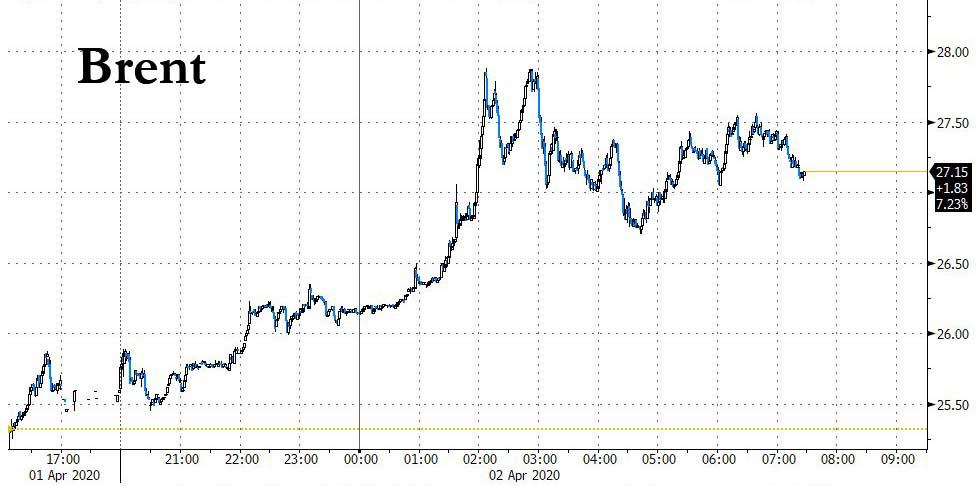
Following massive builds in crude in the US as reported by the DOE and API, and amid sporadic reports that various storage facilities are starting to fill up:
- SALDANHA BAY OIL-STORAGE FACILITY SAID TO BE NEAR CAPACITY
- OIL TANKS AT VITAL AFRICA HUB ALMOST FULL AS CRUDE FLOODS MKT
… overnight, Bloomberg reported that Beijing instructed government agencies to start filling state stockpiles after oil plunged 66% over the first three months of the year, while the global benchmark’s nearest timespread also rallied strongly.
Beijing has asked government agencies to quickly coordinate filling tanks, Bloomberg source said. In addition to state-owned reserves, it may use commercial space for storage as well, while also encouraging companies to fill their own tanks. The initial target is to hold government stockpiles equivalent to 90 days of net imports, which could eventually be expanded to as much as 180 days when including commercial reserves.
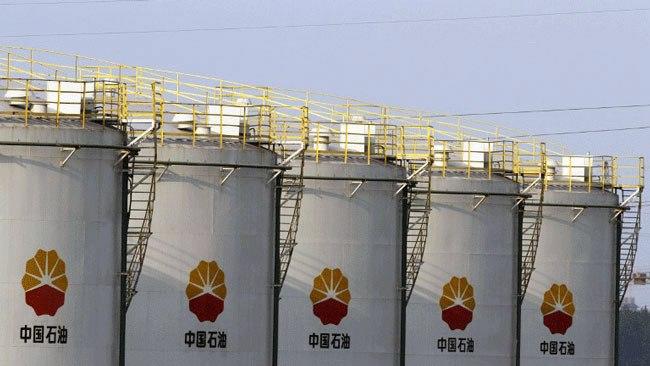
According to Bloomberg calculations, 90 days of net crude imports translated to about 900 million barrels. By comparison, the U.S. currently holds about 635 million barrels in its Strategic Petroleum Reserve, according to government data.
And while the current size of China’s state reserves is unknown, and Beijing could use a different method for calculating net imports, oil traders and analysts at SIA Energy and Wood Mackenzie estimated it could amount to China buying an additional 80 million to 100 million barrels over the course of the year before it ran into logistical and operational constraints.
…click on the above link to read the rest of the article…
WTI Extends Losses After Biggest Crude Build Since 2016
WTI Extends Losses After Biggest Crude Build Since 2016
After its worst quarter ever, as COVID-19 lockdowns crushed demand, raising fears about overflowing storage tanks amid a price war that has flooded the market with extra supply, all eyes are glued to today’s official inventory data (after API reported a major surprise build in crude and gasoline stocks) as Standard Chartered analysts, including Emily Ashford warned in a report, oil tanks around the world could fill in six weeks, a move that will likely force significant production shut-downs,
“Huge inventory builds, potentially exhausting spare storage capacity, will mean that market balance requires an unprecedented output shutdown by producers,” they wrote.
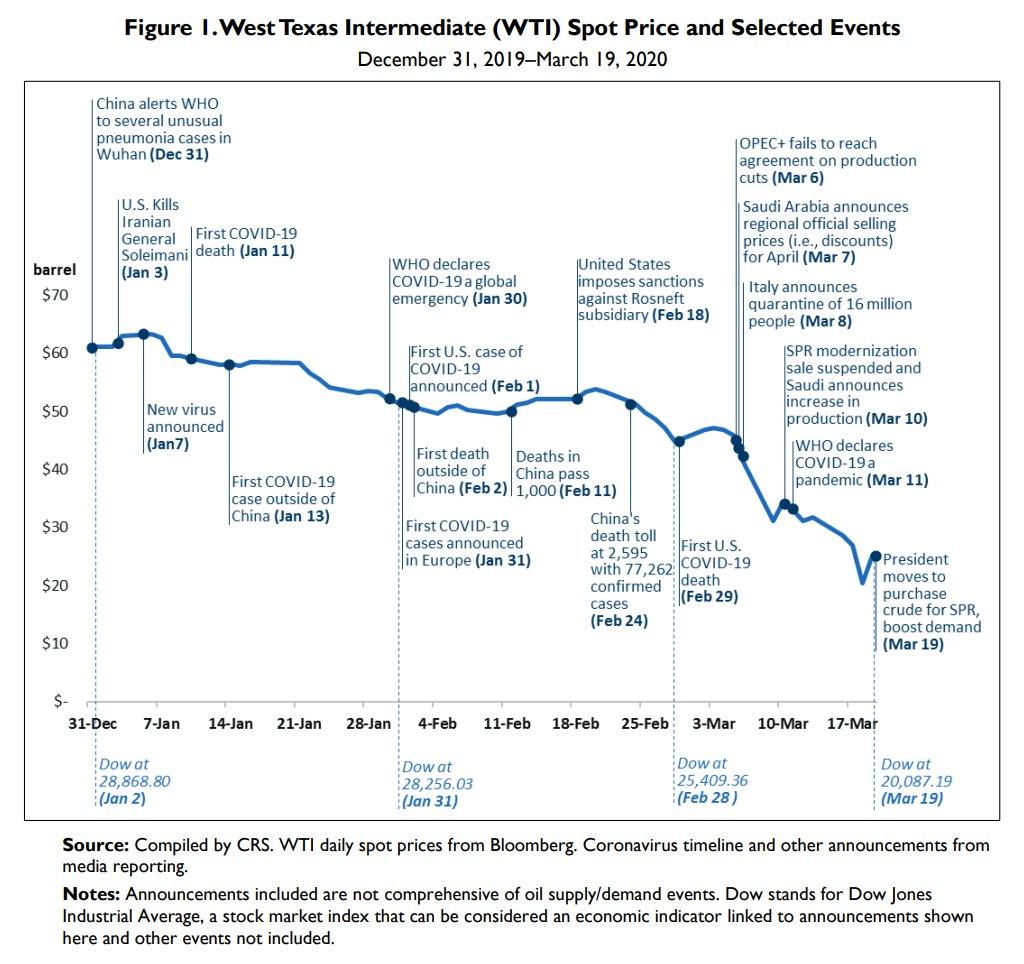
So, eyes down…
“There is the very real possibility that this week’s storage reports could be the energy patch version of last Thursday’s Weekly Jobless Claims,” Robert Yawger, Mizuho Securities USA’s director of energy said in a note.
“I would expect the numbers to be supersized and challenge multi-year highs/lows on multiple data points. Of course, I have been expecting big numbers for the past couple week, but the fireworks have not happened. That leads me to believe that the data explosion will likely happen this week … Exports will likely be down big, and refinery utilization will likely pull back dramatically. That will leave a lot of crude oil on the sidelines … EIA crude oil storage has been higher for nine weeks in a row. Storage will likely double up and increase at the rate of around 10 million for another nine weeks…at least.”
API
- Crude +10.485mm (+4.6mm exp) – biggest build since Feb 2017
- Cushing +2.926mm – biggest build since Feb 2019
- Gasoline +6.058mm (+3.6mm exp) – biggest build since Jan 2020
- Distillates -4.458mm (-600k exp)
DOE
- Crude +13.833mm (+4.6mm exp) – biggest since Oct 2016
- Cushing +3.521mm – biggest build since Mar 2018
- Gasoline +7.524mm (+3.6mm exp) – biggest build since Jan 2020
- Distillates -2.194mm (-600k exp)
Texas Or Canada: Where Will Oil Hit $0 First
Texas Or Canada: Where Will Oil Hit $0 First
Looking at the future of oil prices, Goldman was downright apocalyptic in its short-term forecast, when in a note published this morning, the bank’s chief commodity strategist Jeffrey Currie speculated that as the current production glut “shock” cripples the crude transportation networks, “a producer would be willing to pay someone to dispose of a barrel, implying negative pricing in landlocked areas.” To wit:
The global economy is a complex physical system with physical frictions, and energy sits near the top of that complexity. It is impossible to shut down that much demand without large and persistent ramifications to supply. The one thing that separates energy from other commodities is that it must be contained within its production infrastructure, which for oil includes pipelines, ships, terminals, storage facilities, refineries, and distribution networks. All of which have relatively small and limited spare capacity. We estimate that the world has around a billion barrels of spare storage capacity, but much of that will never be accessed as the velocity of the current shock will breach crude transportation networks first, which we are already seeing evidence of around the world. Indeed, given the cost of shutting down a well, a producer would be willing to pay someone to dispose of a barrel, implying negative pricing in landlocked areas.
A quick look at two of the most popular landlocked oil producing areas demonstrate that Goldman is spot on, and as the following chart shows as of this moment Texas Midland WTI was trading at just baove $10/barrel, while the price of oil produced in the notoriously landlocked Western Canada, as represented by Canada Western Selected index, was just above $4 per barrel, or a little more than what a gallon of gas costs in California.
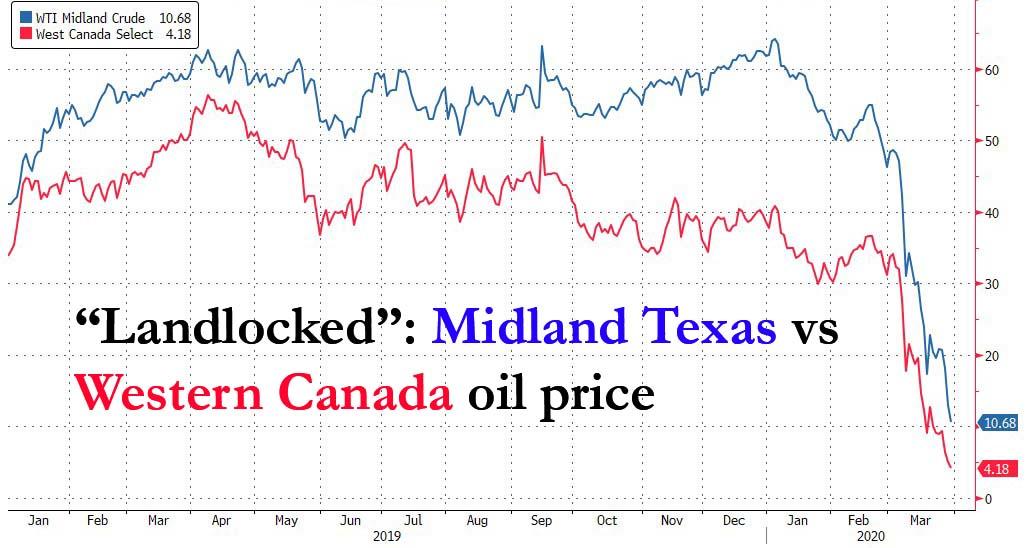
The Unthinkable Is Happening: Oil Storage Space Is About To Run Out
The Unthinkable Is Happening: Oil Storage Space Is About To Run Out
In the past three weeks, oil plunged and has continued to plunge even more in the aftermath of the oil price war declared between Saudi Arabia and Russia, and where US shale (and its junk bonds) has been caught in the crossfire. However, as we reported last week, we may get to the absurd point when the price of a barrel of oil not only hits $0 but goes negative.
The reason: according to Mizuho’s Paul Sankey, at a whopping 15MM b/d in oversupply, crude prices could go negative as Saudi and Russian barrels enter the market. According to Sankey, much of the US 4MM bpd in crude exports will be curtailed as prices fall and tanker rates soar. And with US storage roughly 50% full, and able to take another 135MM bbl more, assuming a build rate of 2MM b/d, the US can add 14MM bbl/week for 10 weeks until full.
As a result, there is a now race between filling storage and negative pricing “unless U.S. decline rates can outpace inventory builds, which we very much doubt.” Said otherwise, absent dramatic changes, in roughly 3 months, energy merchants will be paying you if you generously take a couple million barrels of crude off their hands.
It went from bad to an outright disaster earlier this week when Goldman, Vitol, and the IEA all raised their estimate for daily oil oversupply to an unthinkable 20 million barrels per day, as a result of the collapse in oil demand as the global economy grinds to a halt coupled with Saudi Arabia’s determination to put all of its higher-cost OPEC peers out of business.
…click on the above link to read the rest of the article…
What Happens If Oil Prices Go Negative?
What Happens If Oil Prices Go Negative?

Various reports hit the news feeds today quoting a deliberately headline-grabbing statement by Paul Sankey, managing director at Mizuho Securities, in which he is reported as saying, “Oil prices can go negative.” That is, they could as a combination of Saudi Arabia (and Russia) flooding the market with increased oil and the market running headlong into COVID-19-induced curtailment of activity that is suppressing consumption, which combined will create the perfect storm of excess supply.
In reality, inventory levels are already rising.
CNN quotes Sankey, who said global oil demand is only around 100 million barrels per day.
However, the economic fallout from the coronavirus pandemic could crash demand by up to 20 percent.
This would create a 20 million barrel-per-day surplus of oil in the market that would rapidly exceed storage capacity, forcing oil producers to pay customers to buy the commodity – hence, in effect, negative oil prices.
The American government plans to purchase a total of 77 million barrels of oil starting within weeks the article states, but according to Sankey, this can only be done at a rate of 2 million barrels per day, leaving a massive excess that will be looking for a home.
Brent oil prices have already fallen to the lowest level for 17 years. The consequences for the U.S. oil industry if a coronavirus-induced recession drives down demand could be catastrophic.
West Texas Intermediate crude (WTI) collapsed by a staggering 19.2 percent to $22 while the Mexican Basket is down 22.4 percent.
For a short while, hedges will protect producers and they will continue to pump oil. While that will protect producers for a while, it encourages counter-cyclical practices; producers should be cutting back but instead will probably continue to pump and ship into store.
…click on the above link to read the rest of the article…
“No Deal In Sight” – Oil Plunges After Russia Rejects Additional OPEC+ Cut
“No Deal In Sight” – Oil Plunges After Russia Rejects Additional OPEC+ Cut
Brent crude futures tumbled by more than 4% on Friday after Reuters reported that Russia had rejected steep production cuts by OPEC to prop up oil prices amid the Covid-19 outbreak triggering demand shocks in China and across the world.
A high-level Russian source told Reuters that Moscow has no interest in backing an OPEC reduction that calls for extended cuts and would only agree to existing cuts that OPEC already agreed on.
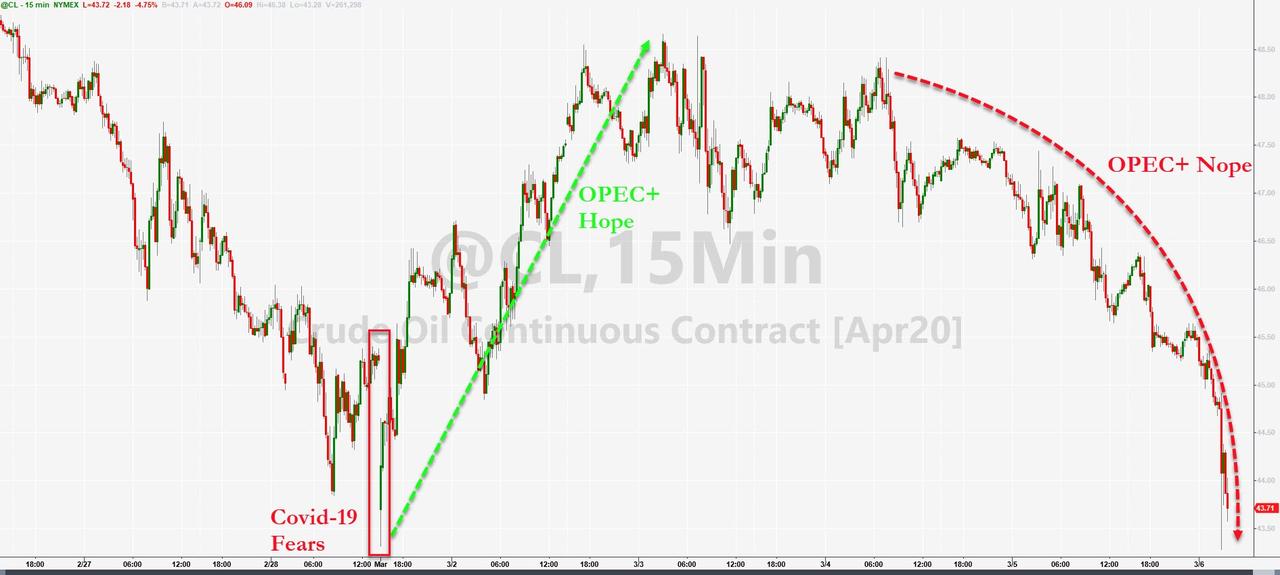
OPEC has held several days of talks in Vienna, Austria, backing an additional 1.5 million barrels per day (bpd). However, it has failed to bring Russia on board. OPEC wants non-OPEC to contribute 500,000 bpd to the overall cut. The new deal would mean OPEC+ would cut a total of 3.6 million bpd, a move that would hopefully lead to a rebalancing in the global oil market in the second half of the year. On Russain disappointment, Brent crude futures dropped to its lowest level since July 2017, trading at $47.70 a barrel, or down 4.5% on Friday morning.
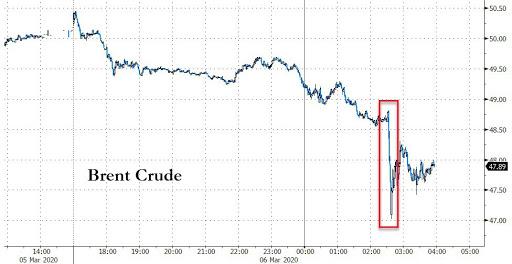
Another source, this time with Bloomberg, said that Russia wants OPEC+ to sustain current output cuts until June. It would then be at that time where more data about market imbalances could be assessed and corrected, the person added.
With Russia taking a “tough stance” on the proposed additional cuts, Commerzbank says Brent futures could extend declines to $40 per barrel. However, if Russia agrees to further cuts, Brent futures would jump to $60 in weeks.
Goldman Sachs maintained its Brent price forecast of $45 per barrel in April.
“Ultimately, a rebound in demand, not supply cuts, will be the necessary catalyst for a sustainable rebound in prices,” Goldman said.
…click on the above link to read the rest of the article…
OPEC Agrees To 1.5MM Barrel Output Cut, But Fails To Obtain Critical Russian Backing
OPEC Agrees To 1.5MM Barrel Output Cut, But Fails To Obtain Critical Russian Backing
Today’s OPEC meeting has been more of a stunt by members to persuade Russia to agree to deep cuts amid a demand shock triggered by the Covid-19.
Ministers from OPEC agreed on a large cut of 1.5 million barrels per day in the second quarter to support prices but made it conditional on Russia joining in, said two OPEC sources, who were cited by Reuters.
Brent crude futures have soared between 6-10% in the last four sessions on OPEC+ JMMC technical committee recommendation, which stated cuts between 750,000 to 1 million barrels per day are needed to stabilize prices. Demand destruction from China and aboard has been one of the most significant shocks to hit global oil markets since the financial crisis a decade ago.
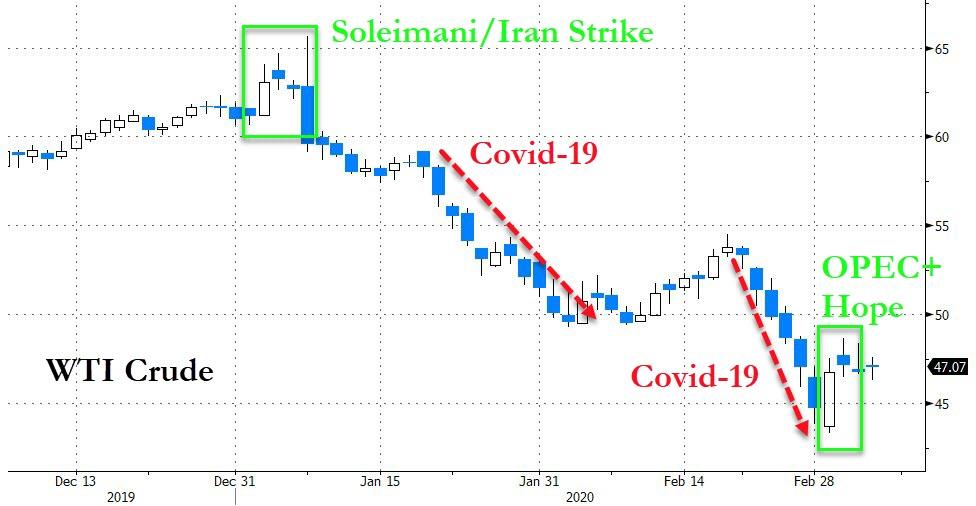
Reuters notes that Saudi Arabia, the largest producer in OPEC, has yet to win the support of Russia agreeing on the cuts.
But that didn’t stop the algos bidding oil higher…
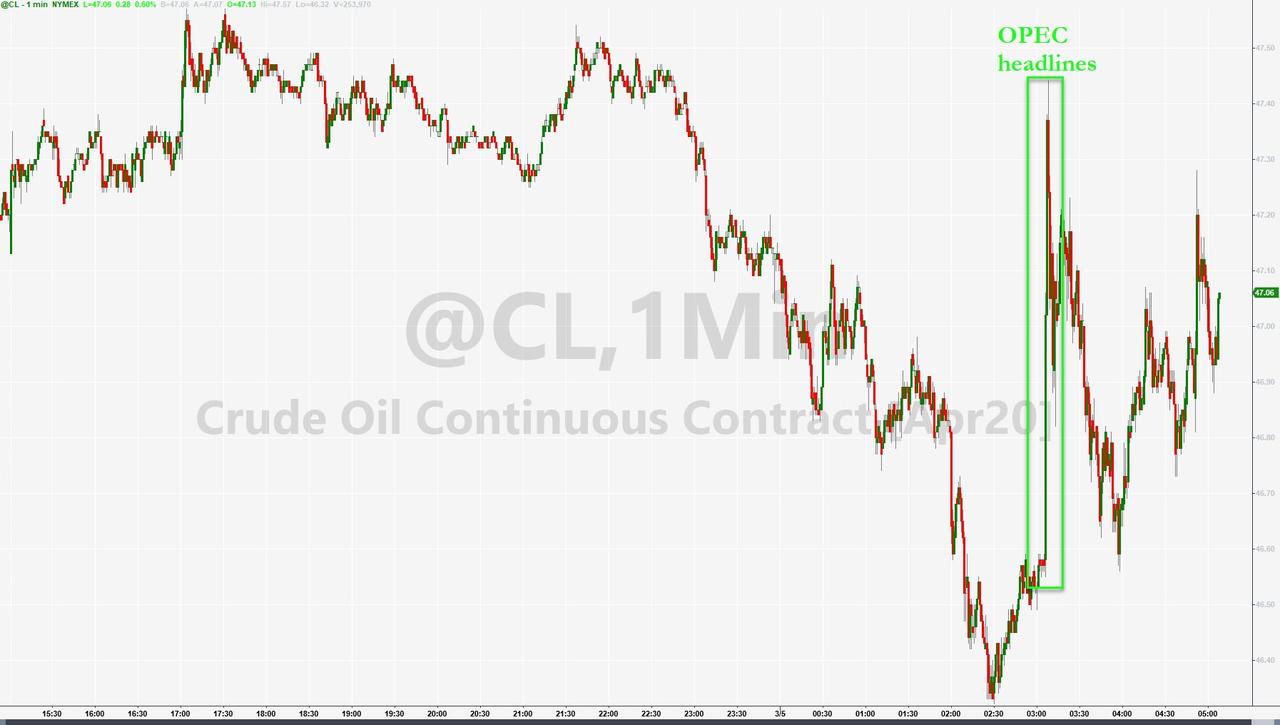
Moscow, which has worked with OPEC+ since 2016 to balance supply, has so far withheld its support for a reduction in output.
Russia’s energy minister left OPEC meetings in Vienna on Wednesday, expected to return on Friday for more in-depth talks.
“Our expectation is that OPEC+ will deliver a credible and coherent strategy that will take more barrels than what’s priced into the market off the table,” Mitsubishi UFG’s Ehsan Khoman told Reuters.
Russia could capitulate on Friday, as it has done everything so far to drag out production cut talks. Still, as we noted yesterday, “Russia will decide on production cuts at the very last minute.”
IEA Sees $90 Crude Ahead Of Oil’s Downfall
IEA Sees $90 Crude Ahead Of Oil’s Downfall
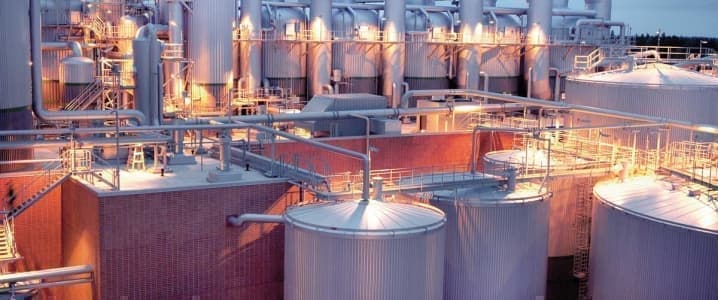
Global oil demand will plateau around 2030, according to a major new report, but the decline in demand is way too slow to head off the worsening effects of climate change.
Oil demand begins to flatten out in the 2030s “under pressure from rising fuel efficiency and the electrification of mobility,” The International Energy Agency (IEA) said in its widely-anticipated annual World Energy Outlook.
However, the agency does not see a peak in CO2 emissions through 2040, even in a scenario that incorporates some intended policy targets. The IEA says that an expanding economy and growing global population outweigh efforts to cut emissions. Reducing emissions will require “significantly more ambitious policy.”
“The dissonance between the rising trend for CO2 and the commitment of countries to reach an early peak in emissions was especially striking in the light of the latest scientific findings from the Intergovernmental Panel on Climate Change,” the IEA said, referring to the rather dire conclusions from the IPCC report in 2018, which found that the world is running out of time to make deep and far-reaching cuts to emissions.
As Reuters reports, some groups criticize the IEA for consistently predicting strong oil demand growth. “The IEA is effectively creating its own reality. They project ever-increasing demand for fossil fuels, which in turn justifies greater investments in supply, making it harder for the energy system to change,” Andrew Logan, senior director of oil and gas at Ceres, told Reuters.
With that said, renewable energy is growing fast and taking a growing slice of all new investment. The IEA sees solar becoming the single largest source of installed electricity capacity by 2040, surpassing coal in the 2030s.
…click on the above link to read the rest of the article…
OPEC Braces For Drastic Drop In Oil Demand
OPEC Braces For Drastic Drop In Oil Demand

OPEC admitted that demand for its oil over the next few years could be drastically weaker than it previously thought, due to a combination of a weakening economy, rising supply elsewhere, and pressure from climate activists.
In its World Oil Outlook, OPEC said that demand for its oil may only reach 32.8 million barrels per day (mb/d) by 2024, a figure that is substantially lower than the 35 mb/d from last year’s estimate. Demand is still expected to grow in non-OECD countries going forward, but OPEC admitted that demand may peak in the OECD in 2020.
Slower economic growth also factored into the lower medium- and long-term estimates. “Given recent signs of stress in the global economy, and the outlook for global growth, at least in the short- and medium-term, the outlook for global oil demand has been lowered slightly this year to 110.6 mb/d by 2040,” OPEC’s Secretary-General Mohammad Barkindo said in the report.
OPEC said that non-OPEC production continues to rise, particularly from U.S. shale, although not exclusively. The cartel has had to restrain production for several years to keep prices from crashing, even in the face of relentless shale growth. U.S. shale is growing, but is now slowing dramatically. At the same time, countries such as Norway, Brazil, Canada and Guyana are expected to continue to add supplies in the next few years. Steady supply increases puts OPEC in a bind.
Meanwhile, the attention paid to the risks of demand destruction in the OPEC report is notable. The phrase “climate change” appears nearly 50 times in the report and the cartel acknowledged that electric vehicles are “gaining momentum.”
…click on the above link to read the rest of the article…
IEA: An Oil Glut Is Looming
IEA: An Oil Glut Is Looming

If global oil demand growth continues to languish with uncertainties around the global economy and Brexit, the oil market will likely have to cope with another oversupply next year, according to the International Energy Agency (IEA).
“Unless other things change, we will see a surplus probably, unless there is very strong demand growth recovery,” Keisuke Sadamori, the IEA’s Director for Energy Markets and Security, told CNBC on the sidelines of an energy event in Singapore on Tuesday.
“Overall, we will continue to see a well supplied market in 2020,” Sadamori said, echoing the IEA’s monthly oil report from earlier in October, which painted a rather gloomy pictureof oil demand growth in the short term.
In the report earlier this month, the IEA cut its demand growth forecast by 100,000 bpd for both 2019 and 2020, to 1 million bpd and 1.2 million bpd, respectively. For the second quarter of this year, the IEA expects oil demand growth to quicken to 1.6 million bpd, thanks to a lower base for comparison in the same period of 2018 and to oil prices that are currently some 30 percent lower compared to a year ago.
Other organizations, as well as analysts, have been also revising down their oil demand growth estimates for this year and next, citing increased uncertainties over the pace of the global economic growth amid the U.S.-China trade war, Brexit, and slowing growth in major economies including China, India, and Germany, for example.
Against this background, the market attention turns again on OPEC and its non-OPEC allies led by Russia, who need to decide in early December how to proceed with their production cut pact expiring in March 2020. There is a growing consensus among experts and observers that the OPEC+ coalition may need to cut even deeper if it wants to prevent a large oversupply building in 2020 and sending oil prices even more uncomfortably low for major oil-producing nations.
…click on the above link to read the rest of the article…
Our Energy and Debt Predicament in 2019
Our Energy and Debt Predicament in 2019
Many people are concerned that we have an oil problem. Or they are concerned about recession and the need to lower interest rates.
As I see the situation, we have a problem of a networked economy that is not functioning well. A big part of this problem is energy-related. Strange as it may seem, energy prices (including oil prices) are too low for producers. If debt levels were growing more rapidly, this low-price problem would go away.
The “standard way” of encouraging more debt-based purchases is by lowering interest rates. But we are running out of room to do this now. We also seem to be running out of economic investments to make with debt. If expected returns on investment were greater, interest rates would be higher.
Without economic investments, demand for commodities of all kinds, including energy products, tends to stay too low. This is the problem we have today. Our debt problem and our energy problem are really different aspects of a networked economy that is no longer generating enough total return. History suggests that these periods tend to end badly.
In the following sections, I will explain some of the issues involved.
[1] Our problem is not just that oil prices that are too low. Prices are too low for practically every type of energy producer, and in many parts of the globe.
Oil: OPEC oil producers have cut back production because they view oil prices as too low. OPEC reports a cutback in production of 2.7 million barrels per day between November 2018 and July 2019 (from 32.3 million bpd to 29.6 million bpd).
In the US, there has been an increase in bankruptcies of oil producers during 2019, relative to 2018. There has also been a reduction in the number of oil drilling rigs of 17% since the week of November 16, 2018, according to reports by Baker Hughes. These are signs of producer distress.
…click on the above link to read the rest of the article…
Yergin: Expect Extreme Volatility In Oil Markets
Yergin: Expect Extreme Volatility In Oil Markets

Rising pipeline takeaway capacity in the Permian and global oil demand growth at its weakest in a decade are set to lead to more volatility in oil prices in the near term, a prominent energy expert said, joining a growing number of analysts who see prices further depressed by slowing economies and crude demand.
“The pipeline bottlenecks are in the process of being resolved, so a lot more oil is going to come onto the market by the end of the year. We expect the U.S. (crude oil output) to be up to 13 million barrels a day,” IHS Markit’s vice chairman Daniel Yergin told CNBC on Tuesday.
While U.S. production will continue to add more supply in an already oversupplied global market, on the demand side, expectations are getting increasingly pessimistic.
“We’re in one of the weakest periods since 2008 and we think demand growth this year is under a million barrels per day. So you have that factor at the same time as you have more oil coming to the market. So expect some volatility,” Yergin told CNBC in an interview on the sidelines of a conference in Abu Dhabi.
Despite expectations of volatility, IHS Markit’s vice chairman sees Brent Crude prices range-bound in the US$55-65 range.
Yergin is not alone in predicting substantially lower oil demand growth this year than originally anticipated.
The International Energy Agency (IEA) revised down its demand growth estimates for 2019 in its latest Oil Market Report, by 100,000 bpd to 1.1 million bpd, after seeing that between January and May demand growth was just 520,000 bpd, the lowest increase for the period since 2008.
…click on the above link to read the rest of the article…
‘High’ Oil Prices Are Already Dampening Demand
‘High’ Oil Prices Are Already Dampening Demand

Crude oil prices are affecting demand for the commodity negatively, the International Energy Agency’s head Fatih Birol told S&P Global Platts in an interview.
“The higher oil price environment may, if they stay around this level, also have an impact…put some downward pressure under demand growth,” Birol said. The warning follows the release of IEA’s latest Oil Market Report, in which the authority kept its oil demand growth projections for this year unchanged at 1.4 million bpd.
The agency’s boss noted that Brent over US$70 a barrel is affecting demand the most in the emerging markets that account for the most of demand growth, including China and India, but also the United States.
“So it will not be a surprise if we are to revise our demand numbers in the next edition of the oil market report if the prices remain at these levels,” he told S&P Global Platts.
For those that are watching oil price movements and the reactions of the world’s largest importers, this is not news. After a slump in the fourth quarter of last year, Brent has rebounded by about 40 percent, trading above US$70 at the moment.
Prices were pushed up by the entry into effect of the latest OPEC+ round of production cuts with Saudi Arabia leading the charge and cutting considerably more than it had agreed to, yet again in a bid to raise prices to levels it feels more comfortable with. However, these are levels that India and China do not feel equally comfortable with.
India relies on exports for more than 80 percent of its oil consumption and China is more dependent on imports than it would like to be. So, it is no wonder that the climb in prices “will definitely hurt oil demand if it soared especially in the important demand growth centers such as India,” according to Birol.
Is This A Precursor For Peak Oil Demand?
Is This A Precursor For Peak Oil Demand?

The $1 trillion sovereign wealth fund of Norway may sell off all of its shares in oil producers.
The move is a shot across the bow for the oil industry. A $1 trillion fund, built on oil itself, now sees the future of oil as too risky.
Norway’s sovereign wealth fund is not getting out of the oil business entirely. The government has only recommended exiting oil and gas exploration and production companies (i.e., upstream producers). The reason why the fund wants to pursue divestment is that it views the long-term oil market as volatile, unpredictable, and at this point, vulnerable to permanently low prices. “The goal is to make our collective wealth less vulnerable to a lasting fall in oil prices,” Norway’s finance minister, Siv Jensen, said. The fund currently holds about $37 billion in oil and gas stocks.
Based on that logic, the government wants to avoid the exposure to producers, since they will be the companies most impacted by changes in oil prices.
But the divestment is also one of the most powerful symbols yet regarding the potential for peak oil demand. The notion of permanently low oil prices is predicated on a peak and decline in consumption. And if a $1 trillion sovereign wealth fund views oil as inherently risky going forward, other investors could begin to fret. It’s worth noting that oil and gas stocks fellimmediately after the announcement.
On the other hand, the selloff could also be viewed in the narrow interests of Norway itself. The sovereign wealth fund was built by oil revenues, so the divestment is a bit ironic. Critics might point out that it is a bit rich for a country that has been, and still is, funded by oil revenues to be taking such a stand on the future of the oil business.
…click on the above link to read the rest of the article…
Oil Market About To Enter Supply Deficit
Oil Market About To Enter Supply Deficit
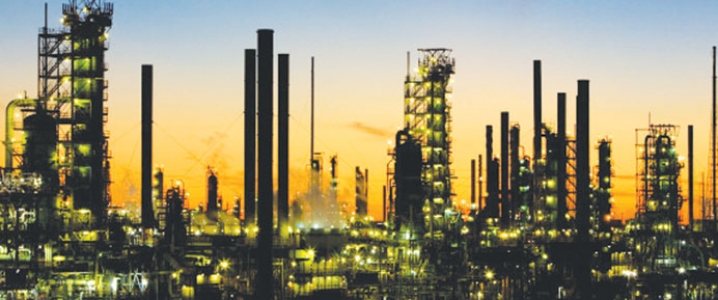
In the latest edition of the Numbers Report, we’ll take a look at some of the most interesting figures put out this week in the energy and metals sectors. Each week we’ll dig into some data and provide a bit of explanation on what drives the numbers.
Let’s take a look.
1. Oil market entering supply deficit
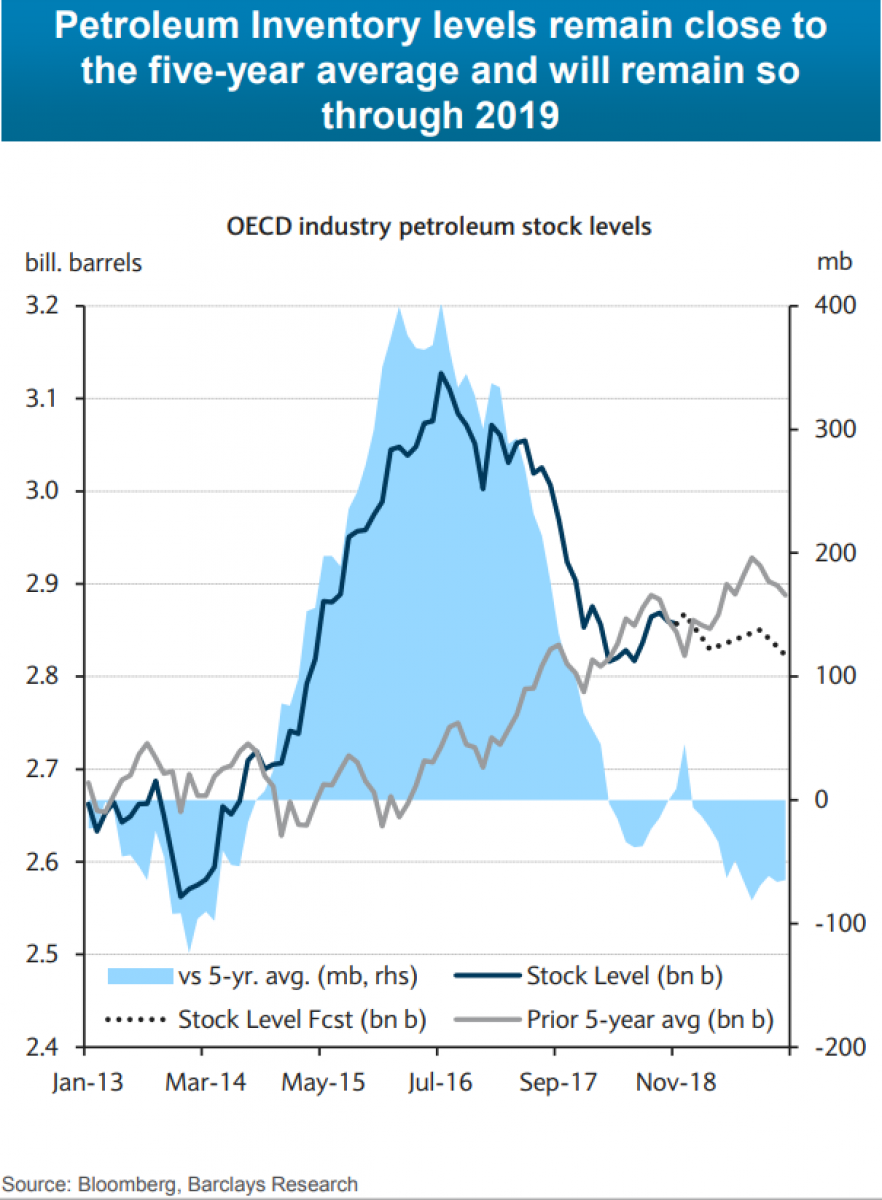
• The OPEC+ cuts have likely already tipped the oil market into a supply deficit, according to Barclays.
• OECD inventories fell dramatically over the past two years, and came back to the five-year average in 2018, where they have mostly remained.
• The OPEC+ cuts quickly headed off a renewed surplus, and will likely drain inventories over the course of this year. Inventories are set to fall below the five-year average.
• Still, Barclays says the market return to balance or even a small surplus in the second half of 2019.
2. China’s oil demand not collapsing

• Some of the more catastrophic oil forecasts for 2019 centered on a sharp slowdown in Chinese demand.
• China’s car sales actually contracted year-on-year over the last few months, and car sales could continue to fall this year.
• But China’s demand, while slowing relative to years past, is still expected to grow by 0.5 mb/d in 2019, according to Barclays, the same rate of expansion as 2018.
• Next year, however, China’s demand growth could slow a bit more, dipping below 0.4 mb/d, continuing a gradual deceleration in demand growth.
3. Cobalt oversupplied, but in high demand

• Kobold Metals, a startup backed by Bill Gates and Jeff Bezos, is hoping to build a “Google Maps for the earth’s crust,” according to Bloomberg.
• The company is building a database of geological data on cobalt, a metal that is often overlooked but is increasingly important to batteries in electric vehicles and the broader shift towards clean energy.
…click on the above link to read the rest of the article…



